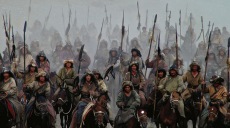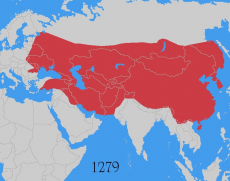
The Mongol Empire, or Mongol Horde, was the largest contiguous Empire in history, originating in the Asian Steppe and completely enveloping so much land that it held within it four different religions and multiple languages. It began in 1206 when the legendary Genghis Khan (pronounced Jengis Karn) unified the warring nomadic tribes of Mongolia under one banner. The Mongols had a reputation for being incredibly fierce warriors and Genghis’ ambition for power spelt doom for much of the world in the 13th and 14th Centuries. The ruler of all Mongols became not a king but a Khan, and the Khanate was named, as you may have assumed, after Genghis Khan the first Khan of Mongolia. He and his descendants brought war and destruction to many peoples, expanding swiftly in all directions. The Mongols did not obey any sort of war etiquette over taking prisoners and treating them hospitably, in fact their conquests resulted in some of the most destructive wars in history. The invasion of Iran became an extermination in which some 10-15 million people died. The destruction was so much that scientists estimate Iran’s population was not back to a pre-Mongol level until the 20th Century, some 700 years after the invasion!
In order to have captured as much territory as the Mongols did so swiftly their warriors had to be fierce. Paralleled by historians to such factions as the Spartans, the Mongols were bred for war, trained from a very young age to ride a horse, fire a bow with deadly accuracy and where to land their blows on well armoured enemies. The swift riding Mongols could dispatch a heavily armoured Christian knight with one quick blow to the neck between his helmet and breastplate. An important part of the Mongols’ success was their battle tactics as much as their skill and training. The horse archers were used as a swift skirmisher force to both whittle down the enemy and lure them towards traps. The stirrups on their saddles (copied from the Huns under Attila) allowed the horse archers to manoeuvre a lot on the horse without falling off as their feet remained held in place but able to swivel. The Mongols faced a great variety of adversaries over their reign of dominance and could adapt their fighting style to match each one with their swift horse archers or strong infantry trained since children in the art of wrestling and hand to hand combat. The Mongols even invented the ‘howling arrow’ which would cause a whaling noise as it flew through the air, chilling the enemy and often routing their horses.

However, like the Spartans these great warriors were not such skilled administrators. Once they had captured all the land it became necessary to maintain it yet they kept advancing. Eventually there was just too many different cultures, religions and languages within the Empire for it to be maintained. Furthermore, after Kublai Khan’s death the Mongol Empire was split into four and, though historians suggest there was no reason they should collapse, internal struggles meant that all four did eventually fade from power.
IMAGE 1: http://static.comicvine.com/uploads/original/11118/111182429/4054761-150,000+mongols.jpg – Some Mongol Horsemen charging into melee combat.
IMAGE 2: https://d3pl14o4ufnhvd.cloudfront.net/v2/uploads/7be47335-caac-4965-8580-b1737a896bd4/0093b2fece0b8284d296438930d9e758cccc56a2_original.jpg - This map shows just how much land the Mongols had captured at their peak.

0 Comment:
Be the first one to comment on this article.